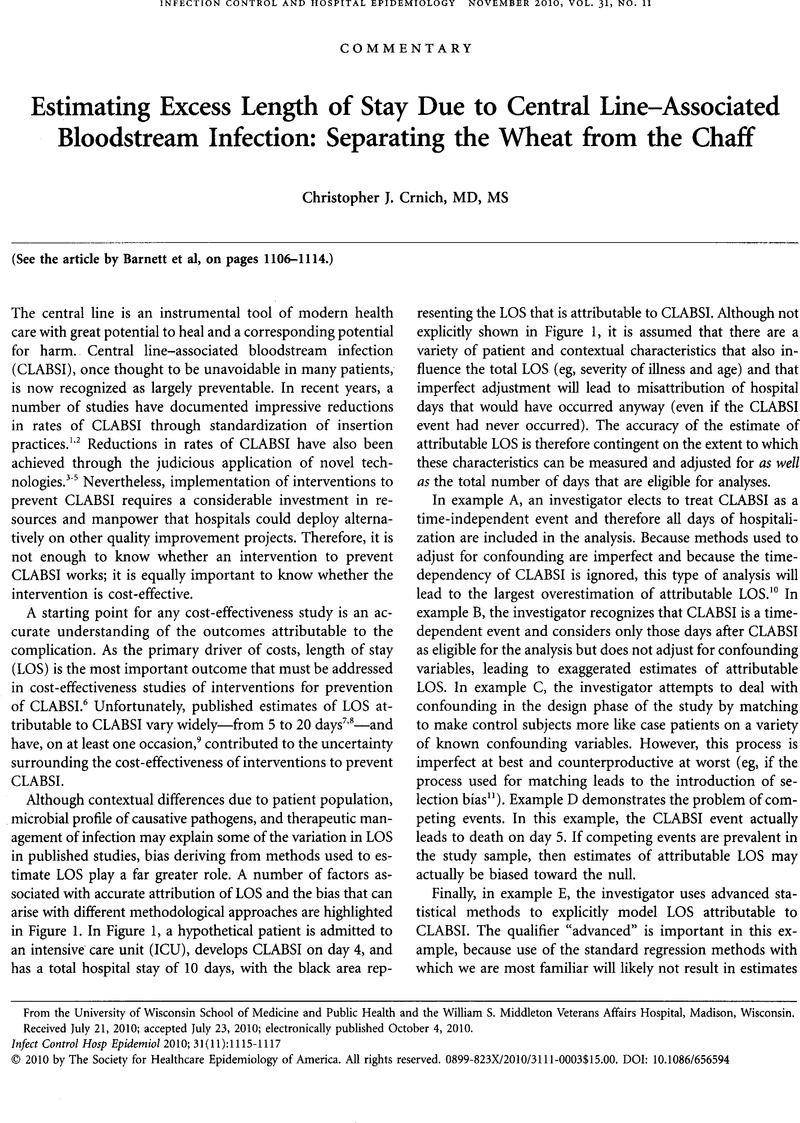Crossref Citations
This article has been cited by the following publications. This list is generated based on data provided by Crossref.
Graves, Nicholas
Barnett, Adrian G.
Halton, Kate
Crnich, Christopher
Cooper, Ben
Beyersmann, Jan
Wolkewitz, Martin
Samore, Matthew
and
Harbarth, Stephan
2011.
The Importance of Good Data, Analysis, and Interpretation for Showing the Economics of Reducing Healthcare-Associated Infection.
Infection Control & Hospital Epidemiology,
Vol. 32,
Issue. 9,
p.
927.
Graves, Nicholas
Barnett, Adrian G
and
Rosenthal, Victor D
2011.
Open versus closed IV infusion systems: a state based model to predict risk of catheter associated blood stream infections.
BMJ Open,
Vol. 1,
Issue. 2,
p.
e000188.
ROSENTHAL, V. D.
UDWADIA, F. E.
MUÑOZ, H. J.
ERBEN, N.
HIGUERA, F.
ABIDI, K.
MEDEIROS, E. A.
FERNÁNDEZ MALDONADO, E.
KANJ, S. S.
GIKAS, A.
BARNETT, A. G.
and
GRAVES, N.
2011.
Time-dependent analysis of extra length of stay and mortality due to ventilator-associated pneumonia in intensive-care units of ten limited-resources countries: findings of the International Nosocomial Infection Control Consortium (INICC).
Epidemiology and Infection,
Vol. 139,
Issue. 11,
p.
1757.
Wright, Marc-Oliver
Tropp, Jackie
Schora, Donna M.
Dillon-Grant, Mary
Peterson, Kari
Boehm, Sue
Robicsek, Ari
and
Peterson, Lance R.
2013.
Continuous passive disinfection of catheter hubs prevents contamination and bloodstream infection.
American Journal of Infection Control,
Vol. 41,
Issue. 1,
p.
33.
Barnett, Adrian G
Page, Katie
Campbell, Megan
Martin, Elizabeth
Rashleigh-Rolls, Rebecca
Halton, Kate
Paterson, David L
Hall, Lisa
Jimmieson, Nerina
White, Katherine
and
Graves, Nicholas
2013.
The increased risks of death and extra lengths of hospital and ICU stay from hospital-acquired bloodstream infections: a case–control study.
BMJ Open,
Vol. 3,
Issue. 10,
p.
e003587.
Schumacher, M.
Allignol, A.
Beyersmann, J.
Binder, N.
and
Wolkewitz, M.
2013.
Hospital-acquired infections--appropriate statistical treatment is urgently needed!.
International Journal of Epidemiology,
Vol. 42,
Issue. 5,
p.
1502.
Gandra, Sumanth
and
Ellison, Richard T.
2014.
Modern Trends in Infection Control Practices in Intensive Care Units.
Journal of Intensive Care Medicine,
Vol. 29,
Issue. 6,
p.
311.
Graves, Nicholas
2014.
How costs change with infection prevention efforts.
Current Opinion in Infectious Diseases,
Vol. 27,
Issue. 4,
p.
390.
Zavotsky, Kathleen
Malast, Tracey
Festus, Onyekachi
and
Riskie, Vickie
2015.
Reducing Central Line–Associated Bloodstream Infections
on Inpatient Oncology Units Using Peer Review.
Clinical Journal of Oncology Nursing,
Vol. 19,
Issue. 6,
p.
655.
Falder-Saeed, Karie
McClain, Kristen
Patton, Lindsey
Langford, Melissa
Marusich, Jennifer
and
Flom, Lindsey
2016.
Teaming Up to Take Down Community-Acquired Bloodstream Infections: A Program Aimed at Educating and Training Nurses in the Community.
Journal of the Association for Vascular Access,
Vol. 21,
Issue. 4,
p.
217.
Norris, LeAnn B.
Kablaoui, Farah
Brilhart, Maggie K.
and
Bookstaver, P. Brandon
2017.
Systematic review of antimicrobial lock therapy for prevention of central-line-associated bloodstream infections in adult and pediatric cancer patients.
International Journal of Antimicrobial Agents,
Vol. 50,
Issue. 3,
p.
308.
Gudiol, C.
Nicolae, S.
Royo-Cebrecos, C.
Aguilar-Guisado, M.
Montero, I.
Martín-Gandul, C.
Perayre, M.
Berbel, D.
Encuentra, M.
Arnan, M.
Cisneros-Herreros, J. M.
and
Carratalà, J.
2018.
Administration of taurolidine-citrate lock solution for prevention of central venous catheter infection in adult neutropenic haematological patients: a randomised, double-blinded, placebo-controlled trial (TAURCAT).
Trials,
Vol. 19,
Issue. 1,
Timbrook, Tristan T.
Wigmosta, Tara B.
Hemmert, Rachael B.
Dimas, Jonathan B.
Krause, Alexander
Spinali, Sébastien
Thelen, Meghan
Tongio, Isabelle
and
Tissier, Jean-Louis
2023.
Measuring clinical outcomes of highly multiplex molecular diagnostics for respiratory infections: A systematic review and conceptual framework.
Antimicrobial Stewardship & Healthcare Epidemiology,
Vol. 3,
Issue. 1,



